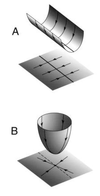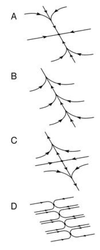How the brain keeps the eyes still
- PMID: 8917592
- PMCID: PMC24094
- DOI: 10.1073/pnas.93.23.13339
How the brain keeps the eyes still
Abstract
The brain can hold the eyes still because it stores a memory of eye position. The brain's memory of horizontal eye position appears to be represented by persistent neural activity in a network known as the neural integrator, which is localized in the brainstem and cerebellum. Existing experimental data are reinterpreted as evidence for an "attractor hypothesis" that the persistent patterns of activity observed in this network form an attractive line of fixed points in its state space. Line attractor dynamics can be produced in linear or nonlinear neural networks by learning mechanisms that precisely tune positive feedback.
Figures


References
Publication types
MeSH terms
LinkOut - more resources
Full Text Sources
Medical

